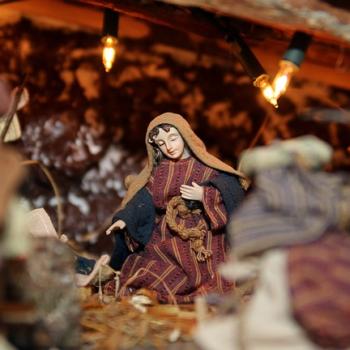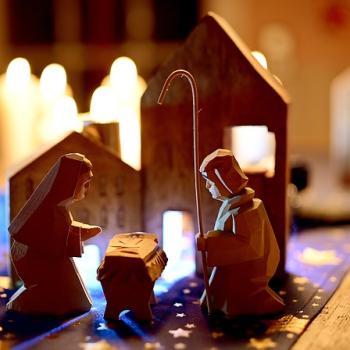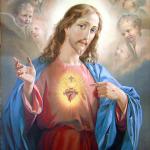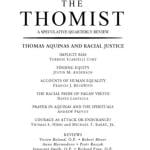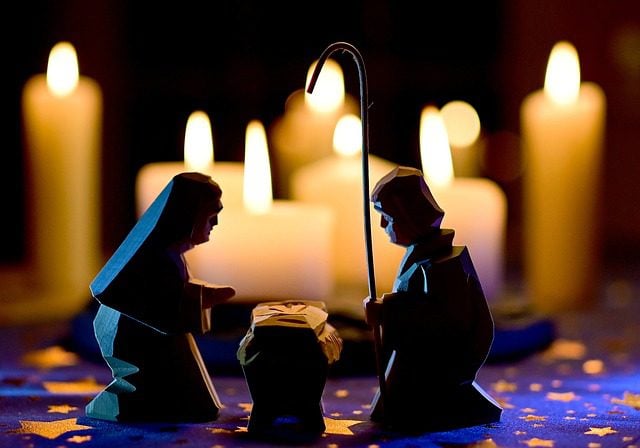
I saw the most unusual portrayal of Mary and Jesus the other day. The name of the piece is “American Nativity” by Kreg Yingst. I saw it on his social media here and read about it here. This is the painter’s website.
If you’ve followed this blog for awhile, you know that I was raised in the Charismatic Renewal and my community had a thing for apparitions. I became terrified of the Virgin Mary because of how she was portrayed. Sometimes I still am. But you also know that I’m constantly looking for ways to think about Mary that help me see her in a better light. I’ve even written a book of meditations on her, trying to understand her in a different light. I love looking at portrayals of Mary from cultures that aren’t mine as much as I cringe at portrayals from my own culture. So I stopped what I was doing and looked at the icon for the longest time.
“He gives sons. Do not be afraid to take Bitter Tears to be your wife. Because the Great Spirit has given her this child. She will give birth to a son and you will name him “Creator Sets Free,” because he will set his people free from their bad hearts and broken ways. Immanuel means “Creator Is With Us.” Matthew 1:20-23.”
I’m told that that comes from the First Nations Version of the Bible. That translation calls Mary “Bitter Tears” because the root of the name “Miriam” is the word for “Bitter.”
I love that God the Father, Creator of the Stars of Night, is behind her wrapped in the night sky. I love that the mountains are dark in the distance, but Christ seems to be encased in a cone of light coming from her womb. I love the cord connecting the two of them, emphasizing her helplessness. I am fascinated by the Four Living Creatures surrounding them, like the four icons on the cover of an Orthodox Bible.
I posted this icon to my Twitter. Most people were as fascinated as I was.
Of course, one person said it was obscene.
I’m used to being told meditations on the bodies of Christ and Mary are obscene. I get screamed at for blasphemy every time someone shares my meditation on Christ as a sex abuse victim, after all. I asked the commentator why she thought it was obscene, and she said it was obscene to portray a birth “realistically.”
I pointed out that a stylized drawing of a woman with no pubic hair bloodlessly squeezing out a nice clean dry baby wasn’t realistic.
The commentator said “Again…what I object to is that Mariam, daughter of Anne and Joachim, wife of Joseph and mother of Jesus, who IS a real woman, in Heaven, might not like to be depicted in this way. Would you draw a realistic picture of your mother giving birth? Would your mother appreciate it?” and she topped off the post with another portrayal of Mary: a GIF of her, looking Caucasian with a full face of makeup, veiled and crowned in colorful fabrics and with a thousand tacky sparkles animated in. The picture glittered like a Barbie dreamhouse.
I was taken aback at the picture. Not because I hadn’t seen similar things a thousand times; I have. You have too. Everyone in the United States and probably all over the world has seen the Mother of Good looking like that in an icon or a prayer card, perhaps without the CGI sparkles.
It strikes me that, of the two portrayals, the glittery one might actually be more offensive to Miriam of Nazareth.
This is the woman who prophesied the Magnificat. She was very excited about the mighty being cast down from their thrones and the rich being sent away empty. And she was, herself, indigenous– a brown-skinned woman whose ancestors had been in Palestine for as long as anyone could remember, with stories about how they’d left due to famine or been dragged away in exile but always come back. She was living under the rule of violent European conquerors. I once got into a ridiculous spat with an Italian woman who wouldn’t admit that ancient Romans were Italians, even though Caesar Augustus said they were, but it’s true. Mary was an indigenous woman living under European colonizer oppression. If you want the real, historic Miriam, she has a lot more in common with the North American indigenous cultures that inspired that beautiful icon than with the white woman who posed for that sparkly painting. And she was not on the side of rich jewel-bedecked royalty. She was excited at the thought of their downfall.
I don’t actually think the GIF is offensive, for the record. I think it’s a tacky but well-meant attempt to portray another truth. Mary is rich in every beautiful, rare and costly virtue, so we sometimes portray her as covered in rare and costly materials. Medieval artists used to portray Heaven as full of gemstones because flowers and trees are perishable but rocks last forever, so they’re more like Heaven. It’s just another way to try and approach an ineffable truth with a painting.
Still, if I have to choose, I see more truth from the American Nativity.
That’s the one that has me thinking about the wonder of the Incarnation today.
Sound off. What are your favorite portrayals of the Nativity?
Mary Pezzulo is the author of Meditations on the Way of the Cross, The Sorrows and Joys of Mary, and Stumbling into Grace: How We Meet God in Tiny Works of Mercy.




